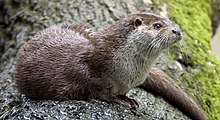
Back Otter Afrikaans ኣቆስጣ Amharic قضاعة (حيوان) Arabic قضاعه ARZ উদ Assamese Lutrinae AST Nikikw ATJ Susamurları Azerbaijani Выдравыя BE-X-OLD Kɔwulu BM
| Otter Temporal range: Middle Miocene to present[1]
| |
|---|---|

| |
| Eurasian otter (Lutra lutra) | |
| Scientific classification | |
| Domain: | Eukaryota |
| Kingdom: | Animalia |
| Phylum: | Chordata |
| Class: | Mammalia |
| Order: | Carnivora |
| Family: | Mustelidae |
| Subfamily: | Lutrinae Bonaparte, 1838 |
| Type genus | |
| Lutra Brünnich, 1771
| |
| Genera | |
|
Aonyx | |
Otters are carnivorous mammals in the subfamily Lutrinae. The 13 extant otter species are all semiaquatic, aquatic, or marine. Lutrinae is a branch of the Mustelidae family, which includes weasels, badgers, mink, and wolverines, among other animals.
Otters' habitats include dens known as holts or couches, with their social structure described by terms such as dogs or boars for males, bitches or sows for females, and pups or cubs for offspring. Groups of otters can be referred to as a bevy, family, lodge, romp, or raft when in water, indicating their social and playful characteristics. Otters are known for their distinct feces, termed spraints, which can vary in smell from freshly mown hay to putrefied fish.
Otters exhibit a varied life cycle with a gestation period of about 60–86 days, and offspring typically stay with their family for a year. They can live up to 16 years, with their diet mainly consisting of fish and sometimes frogs, birds, or shellfish, depending on the species. Otters are distinguished by their long, slim bodies, powerful webbed feet for swimming, and their dense fur, which keeps them warm and buoyant in water. They are playful animals, engaging in activities like sliding into water on natural slides and playing with stones.
There are 13 known species of otters, ranging in size and habitat preferences, with some species adapted to cold waters requiring a high metabolic rate for warmth. Otter-human interactions have varied over time, with otters being hunted for their pelts, used in fishing practices in southern Bangladesh, and occasionally attacking humans, though such incidents are rare and often a result of provocation. Otters hold a place in various cultures' mythology and religion, symbolizing different attributes and stories, from Norse mythology to Native American totems and Asian folklore, where they are sometimes believed to possess shapeshifting abilities.
- ^ Cite error: The named reference
Koepfli2008was invoked but never defined (see the help page). - ^ Geraads, Denis; Alemseged, Zeresenay; Bobe, René; Reed, Denné (2011). "Enhydriodon dikikae, sp. nov. (Carnivora: Mammalia), a gigantic otter from the Pliocene of Dikika, Lower Awash, Ethiopia". Journal of Vertebrate Paleontology. 31 (2): 447–453. Bibcode:2011JVPal..31..447G. doi:10.1080/02724634.2011.550356. S2CID 84797296.
- ^ Switek, Brian. "The Bear Otter". Wired. Archived from the original on 26 August 2020. Retrieved 6 October 2017.